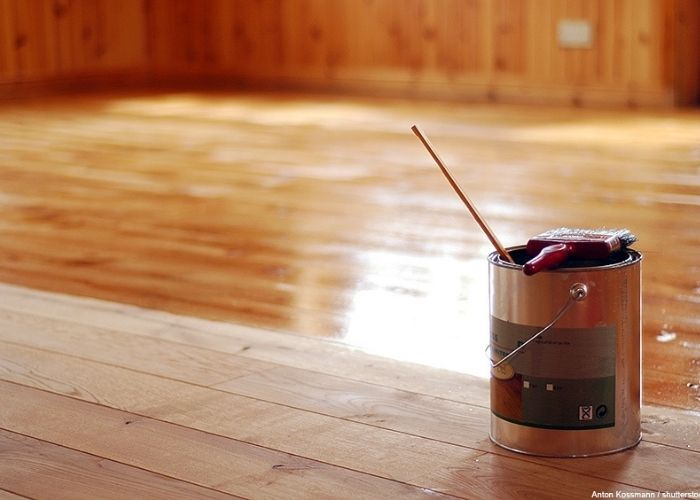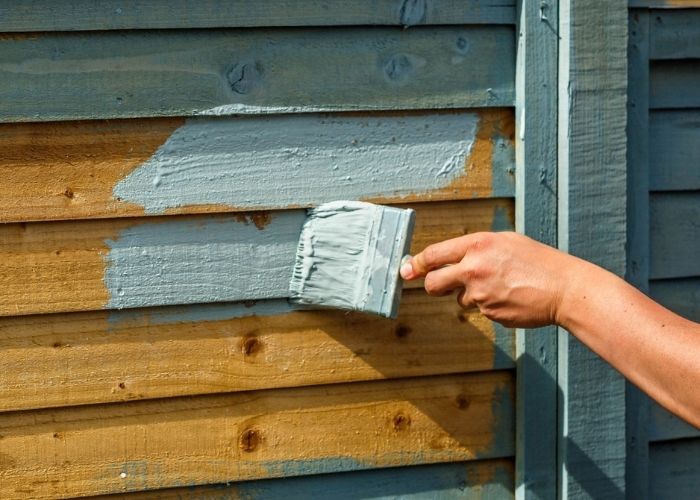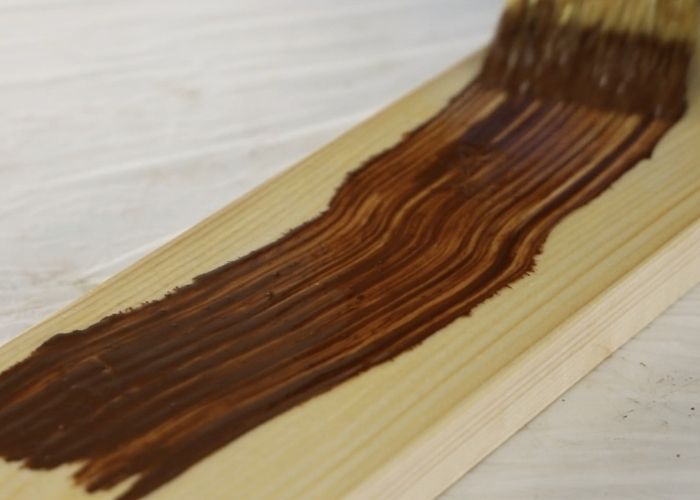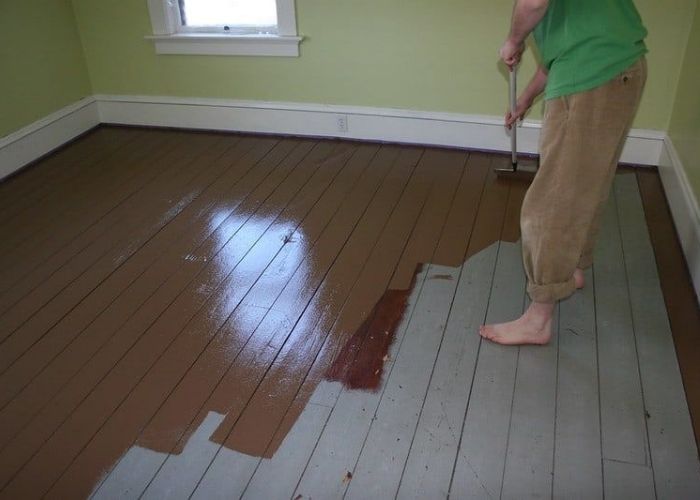Painting is one of the many known ways to finish wood. A good coat of paint enhances the aesthetic qualities of the underlying wood surface.
Additionally, applying paint protects the wood core from weather and other elements that may cause damages, such as scratches.
However, a common question is whether you can use concrete paint on wood. Can you use the paint used to paint cement surfaces on wood?
And, if so, are there any unique preparations or application tips to keep in mind? We answer these and many other related questions below.
Can You Use Concrete Paint on Wood?
The short answer is yes. You can use concrete paint to paint wood, and it’s a choice many woodworkers make from time to time. However, you cannot apply masonry paint directly on a wood’s surface. Instead, you must prep the wood surface accordingly. Otherwise, the epoxy paint used on concrete surfaces may not work well on your wooden surfaces.
Importance of Painting Wooden Products
People paint wooden structures and furniture for different reasons. However, the four main advantages of painting wooden products are;
To protect the wood
Wooden items require protection to withstand the effects of everyday use and exposure to external factors just like walls. For instance, scratching is a real danger if you don’t protect the wood surface. A fresh coat of paint provides insulation from these dangers. Since differentiating various types of paints is not easy, check our guide on wall paint on furniture for clarification.
Control the moisture content of wood
Moisture has a great influence on the stability of wooden structures. Too much moisture can cause wood to rot from the core, while too little moisture can cause warping and loss of shape.
Painting ensures wood items retain their moisture without losing or gaining too much moisture.
Ease of maintenance
No matter how much you seal the wood, it’s impossible to seal the pores in the wood. This is especially true for softwoods.
Unfortunately, these pores often become harboring spots for dust, dirt, and other tiny solid particles, making it hard to keep your furniture clean and sparkling.
Painting solves this problem once and for all, allowing you to clean your furniture with a swipe of a cloth.
What Concrete Paint Will Stick on Wood?

Generally, you should consider oil-based porch and floor paint or oil-based enamel paints. You can get some of the best paint for porch floor from reputable brands that offer excellent adhesion, durability, and resistance to weathering.
Ironically, these are considered not-so-good for concrete painting. Instead, experts recommend epoxy-based paints for concrete surfaces.
If you’re wondering, the difference is significant. Oil-based paints, together with water-based paints, are known as ordinary paints. This is because they comprise one-part oil or water and one-part solids.
Meanwhile, all the two parts of an epoxy paint are 100% solid, typically resin and a hardening agent. Therefore, epoxy is designed to withstand abuse and provide more protection than oil/water-based paints.
Epoxy paint also adheres (clings) to concrete and brick better than oil/water-based paints and provides an attractive high-gloss finish when dried/cured. Epoxy also provides better resistance to mildew and moisture.
Unfortunately, concrete epoxy paints don’t adhere as well to wooden surfaces. Although it will stick, the strength of the bond is questionable in most cases and can come off at some stage down the line.
You need to extensively prep the wood surface and take other measures for epoxy concrete paint to stick on wood. On the other hand, oil and water-based paints easily stick to wooden surfaces even without extensive prepping.
How to Prep Wood for Painting with Concrete Paint

Whichever concrete paint you have, oil/water-based or epoxy garage paint, the following are three critical steps to prep the wood surface before painting wood.
Pressure-wash all the surfaces
Pressure washing allows you to remove dirt, mildew, and other materials for an optimal surface. It may seem unnecessary, but it will help you avoid unsightly marks and an uneven surface at the end of the project.
Sand the surface to remove sealer/varnish
Epoxy concrete paint, in particular, doesn’t stick to varnish, sealer, or old paint. So, you need to sand down the surface to remove any trances of old paint before applying new paint.
Sanding is the best solution as it allows you to scrape away coatings that may interfere with the new paint job.
If it was previously stained, here is how to remove wood stain from concrete.
Prime the surface
Finally, since concrete doesn’t stick very well to wood surfaces, one way to ensure a stronger bond is to use a primer before painting. Wood primer comes in light or dark colors – the choice is yours. For brands like Kilz may leave you in a dilemma about whether can you paint over Kilz primer, as they offer excellent adhesion even on challenging surfaces like wood and concrete.
However, make sure to choose a color that doesn’t interfere with your concrete paint. For instance, if you have white concrete paint, you should choose primer with a light color. And if the concrete paint is black, the primer should be dark.
Can I Use Concrete Stain on Wood?

Yes, you can use concrete stain on wood surfaces. The main difference between the two is that wood stain is like thin paint that merely sticks to the intended surface.
However, concrete stains are typically acid-based. Acid-based stains chemically react with the surface and soak into it, becoming part of the surface.
As such, concrete stains permanently change the color of the underlying surface, usually to make the surface appear newer and fresher.
Therefore, you should be aware that using concrete paint on wood will change the color of the underlying wood surface.
This is because the wood surface will absorb the stain, unlike wood stains that merely sit atop the wood surface. If you’re okay with this, go ahead.
Interesting Post: Can You Paint Over Wood Stain?
Can You Put Concrete Floor Paint on Wood?
Yes, you can use concrete floor paint on wood. Floor paints aren’t much different from regular concrete paint. They are either oil/water-based or epoxy paints designed to withstand high traffic. The paints also come in a wide variety of colors.
If you decide to use floor paint on wood, the most important thing is to prep the wood surface accordingly. Begin by washing it throughout, ideally with a pressure washer, remove any traces of dust or dirt.
Then allow it to dry overnight before sanding vigorously to remove previous paints and sealers. After that, apply primer to ensure a strong bond between the paint and the surface.
What Kind of Paint Do You Use on Wood Floors?
The best paint for wooden hardwood floors is latex or acrylic enamel wood paints. These paints are eco-friendly and durable.
They also produce fewer fumes than traditional oil paints. Remember that oil paints are also banned in many states as they’re bad for human health.
Some of the best latex and acrylic wood paints are;
- Sherwin William’s Porch and Floor Enamel
- KILZ Over Armor Smooth Wood/Concrete Coating
- INSL-X Tough Shield Acrylic Floor and Patio Coating
Related Post: How to Tell if Wood is Stained or Painted
FAQs
Can paving paint be used on timber?
Yes, you can use paving paint, including Ultra Pave, on wooden surfaces and pre-painted surfaces with either water-based or oil-based finishes. Even better, you don’t need to prime the surface before application. Instead, just make sure to apply at least two coats of paving paint.
Can you use sandtex masonry paint on exterior wood?
Yes, you can use Sandtex Ultra Smooth Masonry Paint on sound, dry, exterior masonry painted surfaces. Here too, the most important thing is to properly prep the surface before you start painting.
Can you use concrete epoxy on plywood?
Yes, you can concrete epoxy on plywood. In most cases, you need to apply a flexible epoxy coating over the plywood followed by a self-leveling epoxy mortar. Alternatively, you can begin with the self-leveling mortar.
Can you use masonry paint on wood shed?
Yes, you can use masonry paint on wood sheds. However, you must first prime the wood surface because paint traditionally used on masonry surfaces doesn’t adhere well to an extremely porous surface such as wood.
Some masonry paint also doubles up as the best stair tread paint for wood steps.
Can You Use Wood Stain on Concrete?
Yes, you can use wood stain on concrete, but it is not recommended. Wood stain is designed to be absorbed by porous surfaces like wood in order to color and protect it.
Summary
There you have it – most of your questions surrounding concrete paint on wooden surfaces were answered.
The big takeaway here is that you can use concrete/masonry paint on wood surfaces as long as you lightly sand the surface, wipe off the sanding dust, and apply quality priming material for maximum adhesion.


David, I had my cabinets painted in July and the paint is chipping off very easily. We found out after that he used concrete paint. Could this be the reason.